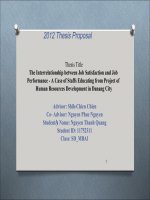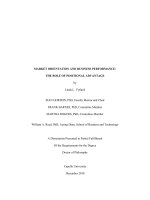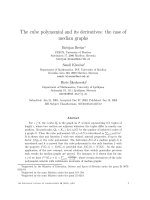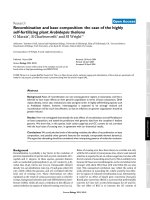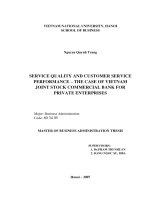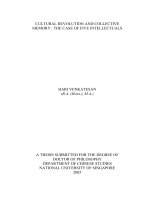Credit growth, macroeconomic factors and ftock performance, the case of hose 2002 2010
Bạn đang xem bản rút gọn của tài liệu. Xem và tải ngay bản đầy đủ của tài liệu tại đây (497.91 KB, 107 trang )
•
UNIVERSITY OF ECONOMICS
HO CHI MINH CITY
INSTITUTE OF SOCIAL STUDIES
THE HAGUE
VIETNAM
THE NETHERLANDS
VIETNAM- NETHERLANDS
PROGRAM FOR M.A IN DEVELOPMENT ECONOMICS
~~~~ CREDIT GROWTH, MACROECONOMIC
FACTORS AND STOCK PERFORMANCE:
THE CASE OF HOSE 2002-2010
A thesis submitted in partial fulfillment of the requirements for the degree of
MASTER OF ARTS IN DEVELOPMENT ECONOMICS
By
NGUYEN THI NGOC HAN
Academic supervisors
Dr. PRAM HOANG VAN
Dr. NGUYEN TRONG HOAI
;;
HO CHI MINH CITY, MARCH 2011
r
fa
L
UEH-- 15Ti
4.
~~It~
I.
··-·- --···
a.. - . ·--·.
---------
-
~-
-~---... 1
·--J·
,..... .
-
-----·
-·
-·-·
TABLE OF CONTENT
1~1rlt()])1J(:1rl()~--------------------------------------------------------------------------------------
1.
4
~11r~Fll\1r1J~ ~~~~=--------------------------------------------------------------------------- 10
2.
2.1 KEY CONCEPTS--------------------------------------------------------------------------------------- 1 0
2.2
TliEOFt!:TICJ\1. I.ITEFlf\T~---------------------------------------------------------------------
11
2.3 ElVfPIFtiCJ\I. I.ITEFlf\TlJFtE-------------------------------------------------------------------------- 17
~~1rll()])()~()(;1{: ----------------------------------------------------------------------------------
3.
25
3 .1 Ftl:S EJ\Ft C II MET II0 D S------------------------------------------------------------------------------ 26
3.2
DJ\TJ\ I>ESCFtiPTION-------------------------------------------------------------------------------- 35
3. 3
I>J\TJ\ J\NJ\I.YSIS------------------------------------------------------------------------------------- 3 7
4.
~SlJ~ 1r A~ A~ 1rSIS:
------------------------------------------------------------------------------- 41
4.1 I> ESCFtiPTIVE J\N J\I. YSI S-------------------------------------------------------------------------- 41
4.2 ST J\ TIONJ\FtY PFtOPEFtTY OF TlME-SEFtiES I>J\ T J\----------------------------------------- 44
·i
4.3 BIVJ\FliTJ\TE FtEI.J\TIONSIIIPS: EG J\PPFtOJ\Cli & GFlf\NGEFt CAlJSJ\LITY--------- 45
4.4
5.
MlJI. TIVJ\Ftll\ TE Ftl:I.J\ TIONSIIIP: JJ PFtOCEDlJFtE, VECM, V J\FliANCE
I>ECOMPOSITION & IMPlJI.SE FtESPONSE FlJNCTIONS---------------------------------- 48
<:O~<:~lJSIO~ AN]) PO~I<:1r ~<:O~~~~])AlliO~S:----------------------------------- 57
5. 1 Ftl:S EJ\Ft CII FINDINGS ------------------------------------------------------------------------------- 51
5.2 POLICY FtECO MMENI> J\ TI ONS------------------------------------------------------------------- 59
5. 3 L11V1IT J\ TI 0 N J\NI> SlJ GG ES TEI> STlJI> IE S----------------------------------------------------- 60
6.
~J?~~~<:~S----------------------------------------------------------------------------------------- 61
7.
J\PP~~])I)(---------------------------------------------------------------------------------------------- 64
;;
2
ABSTRACT
The paper analyzes the dynamic interactions among credit growth, some fundamental macroeconomic factors (exchange rate, inflation, industrial production, interest rate, gold price) and the
performance of Vietnam Ho Chi Minh Stock Exchange using time series econometrics of
cointegration and causality tests. In the analysis, we explore further with VAR-based variance
decomposition and impulse response functions to capture the direct and indirect effects of
innovations in one variable and other ones in the same model. The interesting results come out
with negative reaction of stock price to credit growth in first 11 months of study period before any
reverse trend occurs. And then it will still remain the sign in longer term. However, it seems no
significant evidence to prove the positive short-run impact of credit rate on stock price increase. So
Interest subsidy policy after global crisis (2008) is not the major reason to rescue equity market. In
addition, the variation of key variables including interest rate, inflation and exchange rate has
significant impacts on stock volatility in long run. One important policy implication is that
authorities should be cautious in implementing monetary policies exposed to inflation risk as it has
a consistent adverse influence on stock change in both short and long term.
Keywords:
Credit growth, Macro-economics, Stock performance and
Impulse Response Function.
3
CHAPTER 1: INTRODUCTION
1.1 Research context:
Ho Chi Minh Stock Exchange (HOSE), formerly HOSTC, is the older of the two stock
exchanges in Vietnam. Established on 20 July of 2000, it started operation on 28 July in the same
year. The trading system of all stocks listed in HOSE is under the control of State Securities
Commission (SSC). HOSE runs as a state-owned one member limited liability company with onebillion VND of chartered capital. At the very beginning, there were only two listed firms, namely
REE and SACOM traded two days per week. From 1 March 2002, market traded daily with two
order-matching sessions. Till 31 December 2007, 138 stocks were listed and traded five days per
week through a fully-computerized trading system, Automatic Order-Matching and Put-Through
Trading system. In general, the total capitalization in HOSE accounts for over 40% GOP. During
operating time, Vn-Index had a sharp fluctuation peak to 1137 in February of2007 and then turned
down sharply, which shocked almost investors and policy authorities. According to some former
studies, the root cause is originated from market participant's over-expectation on booming price.
Despite HOSE's certain achievements over year, it is still fragile due to its own high risk,
big price volatility and poor trading system. As one of Asian emerging markets, HOSE has
experienced ups and downs because of the significant influences from external and internal
factors. In reality, many controversial problems signal the market inefficiency and instability in
terms of information asymmetry, a weak legal framework, the lack of transparency in financial
reporting, too much Government intervention in trading transactions and herding investor
4
behaviors. Indeed, these weaknesses are the challenges of Vietnam economy towards financial
liberalization process. Thus, HOSE in particular or Vietnam stock exchange in general hopefully
will develop into a strongly efficient capital-raising channel in the near future.
In the development period, the required tasks for policy makers from now on is to do more
qualified researches on Vietnam stock market and prevailing problems for timely adjustment.
Observing the economic changes since 2002, the rapid domestic credit has grown by nearly 10
times, from about 2 hundred thousand up to more than 2 million billion dong. Simultaneously,
stock market boomed aggressively in 2007 when VN Index created history (Figure 1.1). And the
question whether these two factors have any links has raised the interest in further estimation.
Then its empirical result below can explain the relationship between domestic credit growth and
stock volatility, especially in the period right after the peak in 2007 until the broadening monetary
policy in 2009.
Figure 1.1: VN-Index & Credit aggregate in 2002Ml-2010M3
5
VNINDEX
1,000
800
600
400
200
2002
2003
2004
2005
2006
2007
2008
2009
DOMESTIC CREDIT
2,000,000
1,600,000
1,200,000
800,000
400,000
2002
2003
2004
2005
2006
Sources: IMF (20 10)
6
2007
2008
2009
Let's discuss more about Vietnam economic background and why credit growth
accelerated the period prior to 2008. A relevant update from World Bank (2007) gave some
explanation related to the so-called "Impossible trinity" of simultaneously maintaining nearly
fixed foreign exchange, independent monetary policy and an open capital account. Under this
implementation, the incident following increasing capital inflows was foreign exchange
depreciation or domestic currency appreciation that kept appealing more investors. The economy
was put in a challenge of excess liquidity. Due to its negative impact on Vietnam competitiveness
of export and growth slow-down, the Government intervened by purchasing foreign exchange and
selling securities. Then it moved foreign exchange market much flexibly. However, the foreign
reserve accumulation and VND appreciation forced SBV to choose monetary and credit expansion
in term of sterilization. This also hid potential exposure to
inflation and then unpredictable capital outflows, most seriously a crisis (2008) when the stock
value returned its real value. So it raises the interest in finding the real impact of credit growth on
stock performance scientifically over the period which will be presented in the following parts.
1.2 The scientific challenge:
The research will discover whether credit shocks have significantly affected HOSE
performance. Particularly, the credit growth under interest support program in 2009 aimed at
economic stimulation after global crisis in 2008. And thesis also generalizes how lagged length
between credit growth and stock price reaction would be. Further estimation will uncover which
of key macroeconomic and trend variables has remarkably influenced on stock price in both short
and long run since 2002. Based on the empirical result, stock investors, academic
!
economists and authorities can refer to the findings for their own decision-making. However,
7
some existing limitation of data and quantitative tools to interpret it in economic meaning are
necessary for further research then.
1.3 Goal and objectives of the research:
The overall goal of the project is to provide scientific results as trustworthy references for
stock investors. And then it gives some appropriate policy recommendations related to credit
applicable for the development of Ho Chi Minh Stock Exchange and Vietnam economy as a
whole.
To meet the goal, the first specific objective of the research is to identify the cointegration
and causality of domestic credit growth to HOSE's performance. Next is to analyze the lag length
between the prominent change in some monetary policies and its impact on stock price market
over 2002-20 I 0. Especially and specifically, how Decision 131-2009-QD-TTg on Interest Rate
Support for Organizations to expand their Production and Business affected stock price will be
discussed in the paper. By application of VAR and monetary transmission mechanism (MTM), the
research functions forecasting the stock volatility.
The second objective is to explain more about interactions among credit growth, other key
macroeconomic indicators and HOSE index. The testing will identify how significant and which
relationships, negative or positive, each independent macro-variables impact on the dependent
stock price.
The last is to gtve some recommendation for both stock exchange managers and
government policy makers.
8
1.4 Research Questions:
In order to achieve the above objectives, let's try to answer the following questions:
1. Is there any relationship between credit growth rate and stock price index in long-term
as well as short-term?
2. Among potential substitute investment channels via foreign exchange, gold, money
and overseas stock markets, does domestic interest rate have the immediate effect on
the stock price variation?
3. Associated with credit, are all selective macroeconomic factors necessary for
forecasting HOSE price change in the long-run? If yes, what is the sign of individual
relationship between stock price and the others?
1.5 Structure of the thesis:
The thesis will follow introduction section with four other chapters. Chapter 2 reviews the
applicable theories of stock price determination as well as empirical studies about the relationship
between security index and macro-economic indicators. Chapter 3 describes research
methodology including data collection, variables of interest, econometric model together with
empirical procedures. Chapter 4 analyses the research results according to methods recommended
previously. It answers the thesis hypotheses whether the causality of Credit growth to stock price
change exists, which market the main substitute for stock investment channel is and whether other
macro-variables have significant impacts on stock variations. And chapter 5 closes the study with
a conclusion, policy implication and opens with its limitation for further studies.
9
CHAPTER 2: LITERATURE REVIEW FOR STOCK'S RELATIONS WITH MACROECONOMIC FACTORS
This section will provide general concepts and previous valued researches based on which
the study can construct. It includes four main parts: key concepts, theoretical review, empirical
review and conceptual framework.
2.1 Key concepts:
2.1.1 Credit channel
Credit channel as suggested by Mishkin (1995) operates through two components - the
balance sheet channel and the bank lending one. The concept explains that increasing money
supply increases total credit that banks can supply to country economy. And then through the bank
financing channel, it will in tum boost aggregate demand and output, eventually push up stock
price. In line with the balance sheet channel, Bemanke and Gertler (1995) concerned the external
finance premium, which they defined as the bridge between the externally-raised cost of funds and
the opportunity cost of internal funds. Yet, this seems not significant in the case of Vietnam
because most credit has recently been granted to big state-owned enterprises regardless ofthe
consideration of their financial position. Briefly, domestic credit growth via banking loans is the
channel the State Bank uses to inject liquidity to the whole market.
2.1.2 Macro-economics
Macroeconomics is the study of the performance, structure and behavior of the entire
economy as a whole. It is different from microeconomics which focuses more on individuals and
10
how they make economic decisions. Actually, macro-economy is so complicated because there are
many factors influence on it. We usually analyze macro-economy by primarily looking at national
output (GDP), unemployment and inflation. Besides, there are consumption, interest rate, foreign
exchange, international trade and international finance which are modeled to explain economic
relationships. The study herein will employ some of the mentioned indicators to see how they
affect stock market.
2.1.3 Stock performance
Stock performance is a measure of the returns on shares over a period of time. There are
several measures of stock performance and each includes its own characteristics and benefits
during an analysis of returns. In order to understand stock performance of HOSE in Vietnam, the
thesis will employ stock index (VN-Index) as its proxy.
2.2 Theoretical literature:
2.2.1 Arbitrage Pricing Theory (APT)
This research is drawn from Arbitrage Pricing Theory (APT). Developed by Stephen Ross
(1976), the theory asserts that an asset's expected return is a linear function of unanticipated
change in a small number of macroeconomic factors. The sensitivity of the asset's return to the
individual elements is determined empirically by way of statistical technique. The APT does not
identify the specific factors that would affect asset returns. Yet four factors are frequently
evaluated in most application of the APT: (1) inflation, (2) industrial production, (3) risk premium
and (4) the term structure of interest rate. Different from Capital Asset Pricing Model's risk
measure by asset "beta" against market index, the four forces are primary
11
influences on stock market. Based on the traditional discounted cash flow valuation, the
unanticipated variations of inflation rate and industrial production are related to the real value of
future cash flow. The other two variables seem intuitively to be more linked to the risk-adjusted
discount rate. Risk premium measures investor attitudes toward risk perception about general level
of economic uncertainty while the term structure of interest rate influences on discount rate for
multiply year cash flows. However, the study did not show the evidence to deny the rest of
unsystematic variables affecting asset returns.
2.2.2 Discounted Cash Flow (DCF)
These four above factors find based on a common financial theory, namely, Discounted
Cash Flow valuation (DCF) which was identified by Chen Ross & Roll (1986). It is one of the
foundations to estimate the true value of common stock investment. Since the study aims to
identify key determinants of stock's true value rather fundamental analysis, Dividend Discount
Model (DDM) is suitable for review in this section. The model assumes that the time money value of
common stock is the present value of all future dividends. In the following equation [2.1 ], interest rate
and inflation affect discount rate and future cash flows while industrial production reflects the health of
business performance via dividend payment to shareholders.
Where
Vj: Value of common stockj
Dt: Dividend accrued from period t
Ke: Cost of Equity
12
Assume that the dividend growth rate holds constant (g%), the time value of stock is written in
form ofthe following function.
.
Where
DI
Vj = -- [2.2]
ke-g
D 1 : Dividend in period 1
ke: Cost ofEquity
g : Constant growth rate
Based on the above function, there are 2 fundamental determinants, cost of equity and expected
growth rate, to examine the intrinsic value of a stock. They are independent to each other pursuant
to Keilly and Brown ( 1997). Growth rate depends on retention rate (b) and return on
equity investment (ROE) via the function: g = b * ROE while ke stands for risk factors. Total risk
is a combination between systematic risk (market risk) and unsystematic risk (firm-specific
financial risk). Systematic risk is the variability of return on stocks or portfolio associated with
changes in return on the market as a whole whereas unsystematic one is also the return variation
but not explained by general market movements. It is avoidable through diversification of risk,
investment stock portfolio. In regard to market an aversion investor can look at investment
macroeconomic and political conditions for their
decisions. Damodaran (2002)
demonstrated determinants of ke as a function of interest rate, inflation, exchange rate, news
about economy and political stability. On the other hand, disregarding reinvestment rate b
determined by individual firm's dividend policy, ROE in the equation of growth rate should be
concerned. It is affected by the financing decisions of each firm via
13
ROE=ROC+D/E.[ROC-r(l-t)] [2.3]
•
Where
ROC: Return on capital investment
D/E: Capital structure (Debt over Equity)
r: Interest expense on debt
t: Tax rate on ordinary income
Therefore, expected growth rate of a stock will eventually base on both monetary and fiscal policy
changes since r is related to monetary policy and t refers to fiscal one. From all above-mentioned
equations, we can conclude that the change in stock price would be partially determined by macroeconomic variables related to interest rate, inflation, industrial production, exchange rate, money
supply, credit aggregate, taxation and government budget. The research will employ some similar
fundamental indicators based on this theory.
2.2.3 Inflation and Stock Market
Beside APT and DCF, two alternative studies about why inflation affects stock price were
discussed in Feldstein ( 1980) and Modigliani -Cohn ( 1979).
Feldstein's "Inflation and the Stock Market" indicated the inverse relation between higher
rate of inflation and sustainable reduction in the ratio of share prices to pretax earnings. But what
was the cause to the failure of price increase during a decade (1980s) of steady inflation in US?
This adverse effect resulted from the features of State tax laws, particularly historic cost
depreciation and the taxation on corporate-source income. Further, the study
14
analyzed the difference between the effect of high constant inflation rate and its increase expected
for future. If the steady-state of inflation rate is higher, stock prices would go up at faster rate. And
an increase in expected future of inflation rate would lead to a concurrent fall in the ratio of share
price to current earnings (PE). Then the price rises at higher rate of inflation but PE ratio will be
permanently lower as inflation pushes up the effective tax rate on corporate revenue. Despite
Feldstein's affirmation on the inverse influence of inflation on stock price via US tax regime, he
did not deny the anticipated factors - the slowdown in productivity growth, booming cost of
energy and increasing international competition - decreasing pretax profitability. Sharing the same
view of the negative relation between inflation and stock price, Modigliani-Cohn approached it in
different ways. The reason why the ratio of market value to profits declined in the late 1960s is
two errors in evaluating common stocks. The first is that investors capitalize equity earning at a
rate which is equal the nominal interest rate not economically correct real rate. The second is that
investors fail to allow for the gain to shareholders accruing from depreciation in the real value of
nominal corporate liability. In other words, the inflation-induced errors are exposed to a
permanently depressing effect on reported earnings even to the point of turning real profit into
growing losses. In short, the rate of inflation is an indispensable proxy to measure the uncertainty
of an economy in general or stock market in particular.
2.2.4 Monetary Transmission Mechanism (MTM):
One more applicable theory within the analysis is Monetary Transmission Mechanism
(MTM). It describes how a monetary policy change affects some important macroeconomic
variables. The specific channels of MTM operate through the effects of monetary policy on
interest rates, exchange rates, equity and real estate prices, bank lending and corporate balance
15
sheet. According to Mishkin (2006), the increase in money supply may lead the rise of price level
and potential growing real output in the short-run, which can occur through four typical channels
like interest rate, credit, exchange rate and asset price channel. In case of Vietnam, the
credit channel explains much of the way in which credit as money supply affects real output. It is
more important than interest rate channel resulted from a study of Le Viet Hung, an expert from
Foreign Exchange Department (2008).
2.2.5 Efficient Market Hypothesis (EMH):
Lastly, one of the most influential theories of asset pncmg
IS
Efficient Market
Hypothesis (EMH) developed by Fama (1970). It asserts that financial markets are
informatively efficient when market prices incorporate and reflect all relevant available
information. There are three forms of market efficiency. If all available information is related to
past prices, it is classified into "weak form". And if it refers to all public information, the market is
defined as "semi-strong form" efficiency. Otherwise it would be "strong-form" when share prices
adjust to all public and private information. In the last form, investors cannot consistently earn
excess returns over a long period of time. The theory has a lot of disputes and controversy,
especially from technical analysts as they base their expectation on past prices, earnings track
records and other indicators to predict the market trends. In reality, it is very hard to become a
strong-form efficient market due to asymmetric problems.
According to the above-mentioned theoretical review, there remain two signs of the
dynamic interactions running from the key macro-economic factors to stock price. The negative
sign refers to the causality of interest rate, inflation and exchange rate to stock index. And the
positive exhibits its correlation with money supply and industrial production. Different from the
16
previous analytical evidence, the thesis is developed to find out some specific relationships among
key macro elements and the proxy variable of stock performance in the case of Ho Chi Minh Stock
Exchange. First of all is whether a consecutive credit growth, main independent variable, over
studying period has any impact on VN-Index immediately or within 12 months. The research
interest is raised from whether the same upward trend of data series (Figure 1) over years presents
a cointegration in long term and a causal relation in short term. Second, as observed Vietnam
investment market from 2002 up to now, almost individual investors have changed the strategies
toward money market when there are negative risk signals from stock market. Banking deposit is
one of safe substitutes. That is the reason why the research wants to answer if money market is the
most active investment alternative for equity in short-run. One more discussion is the author's
ambition to understand whether 4 selective variables of interest, credit growth, foreign exchange,
interest rate and inflation, have forecasting abilities to stock volatility in long-run.
2.3 Empirical literature:
Ibrahim and Yusoff (200 I) from Malaysia employed mainly VAR, Johansen-Juselius Cointegration, Monetary Transmission Mechanism and AS-AD model to analyze the relationship
between Kuala Lumpur Composite Index (KLCI) with selective macro-indicator including M2
monetary aggregate as money supply, real industrial production to capture real economic
activities, CPJ and exchange rate (Ringgit/USD) expressed in natural logarithms. All the data
were collected in the period of Jan 1977-Aug 1998. As a result, they concluded that more money
supply leads to more positive effects on stock price in short-run and vice versa in long-run.
r
-...
r
{J
•:Ji .
r
_l.]_ -
~
rss
----
-,
• -.
••,.
I
...11.....
Conversely, changes in stock price also drive the increase in demand for real money, interest rate
and subsequently the value of domestic currency. Furthermore, domestic currency depreciation
presented by exchange rate appreciation is both contractionary and inflationary. Therefore,
Malaysian authorities should pay attention to stabilizing their exchange rate and monetary policies
due to its adverse repercussion on financial market.
CooperMaysami, Howe and Hamzah (2004) tested the interactions between chosen factors
including interest rate, industrial production, price level, money supply, exchange rate and
Singapore Exchange Sector Indices of Finance, Property and Hotel by applying Johansen's VECM
model ( 1990) in multivariate context, a full information maximum likelihood estimation model.
Based on intuitive financial theory (Chen et al. 1986 & Fama 1981 ), the model allows for testing a
whole system of equation in one step and avoids carrying over errors from the first into the second
step. And the conclusion drawn from its empirical study is that Singapore stock market and SES
Ali-S Equities Property Index formed significant relationships with all macroeconomic variables
identified while the other two did with only selected ones. Specially, the financial sector is
significant affected by inflation rate, exchange rate and both long and short-term interest rate
whereas its relation to money supply is weaker in comparison with Singapore's stock market as a
whole. From this point, the authors came up with a statement that "stock picking" could lead to
superior earning capability.
Another research is from the case of Norwegian stock market. Anderson and Lauvsnes (2007)
did a research on co-integration between stock price index and domestic credit instead of money
supply used by other previous studies for forecasting purpose. Various methods and comparisons
were employed in their study. First, they compared forecasts from VAR models with and without
imposing co-integration restrictions with simple uni-variate models in different
18
forecasting horizons. Then it stepped up with comparing Mean Square Errors MSE and Mean
Absolute Errors MAE from 4 models: VAR log-differences, VAR - VECM, Random walk,
ARIMA(l, 1,1) in Box-JENKINs analysis. According to many problems happening since 1980s,
they particularly found financial turbulence with booms in stock markets, a strong overall growth
in credit and asset prices (property & stock), concerns about sustainability of domestic private
credit via excessive borrowing causing to increases in cost (e.g. interest rate) and reduction of
income as the result. In next step, these scholars tried answering relevant hypothesis: How to
improve stock index and credit growth forecasts? What are the fragile endogenous relationships in
economy (Minsky1987)? Does previously detected co-integration between these variables
contribute to forecast accuracy? Additionally, they addressed comparison between the out-ofsample forecast and previous in-sample results. They scientifically figured out the results that
Stock index is better predicted when co-integration is imposed. Credit variable is better predicted
with multivariate models than the uni-variate ones.
In the case of Thailand, many scholars from different approaches identified macro-economic
elements affecting their stock market performance. In 2007, Tantatape and Komain used cointegration model to test the long-run relationship and ECM to determine short-run deviation from
long-run equilibrium. The study collected monthly data of Money supply, FX, IPI and Oil price,
Inflation rate logarithm (1992-2003). In addition, Mahmood and Dinniah (2007) expanded their
study of 6 Asia Pacific countries consisting of Malaysia, Korea, Thailand, Hong Kong, Japan and
Australia to make a comparison at regional level. With the similar methodology
(ECM) and observation periods but less independent variables (exchange rate, inflation rate and
industrial output), the results came up with the co-integration between stock price and exchange
rate in Hong Kong market and industrial output in Thailand during 1993-2002. And
19
macroeconomic indicators in other countries seemed to produce a negligible impact on stock
return. From different approaches, Nguyen Dinh Tho (2010) employed Arbitrage pricing theory
(APT) to explore the behaviors of Thailand stock price against the changes of macroeconomic
factors. Moreover, the research discovered its relationship with exchange rate, IP growth rate,
inflation rate, current account balance, international-domestic interest rate difference and the
changes in domestic interest rate. He collected monthly dataset before Asia Financial Crisis (from
Jan 1987 to Dec 1998) to compute all with basic test of correlation coefficient to avoid multicolinearity, auto-correlation, ADF unit root test and finally OLS. The reliable result was thanks to
various tests on flexible combination of endogenous and exogenous variables. The study ended
with "Industrial production and exchange rate systematically affect stock returns while the returns
on value weighted SET index, used as a proxy of market portfolio, fails to show its significance".
Regarding a limited number of empirical studies in Vietnam, Loc, Lanjouw and Lensink
(2008) conducted auto-correlation together with variance-ratio tests to discover whether Vietnam
stock market holds weak-form efficiency. It also answers the question if there is a possible bias of
the results caused by thin-trading that characterizes the market. The employed data was collected
on weekly basis (2000M7D28-2004M12D31). The findings scientifically reported that Stock
Trading Center (STC) is not weak-form efficient in thin-trading period, even in case, its
corrections of thin-trading are made. In the same year, Long (2008) used daily data of closing
stock price and return rate of index (%) in 2000-2007 period to examine stock return volatility
against regime changes. By testing in GARCH model, his predominant outcome proved that
Financial Liberalization has a negative influence on stock return variation. However, it is not easy
to separate the influence of Financial Liberalization on stock performance from that of the
20
growing number of IPOs (Initial Public Offering) because they coincided during research period .
•
Then Khuyen (2009) investigated the efficiency of Vietnam stock market via the lagged impact of
twelve macro-economic monthly variables in 2000M12-2009M6. These factors represent for Real
Production, Foreign Trade and Money Market indices. The time series were processed in order by
Stationary test, Cointegration and Granger Causality tests in both long and short run. The results
form multivariate analysis reinforced that Vietnam stock performance is not informationally
efficient. Thus, it is possible for any trader to earn abnormal returns by understanding good or bad
news of macro-economics. Besides, the articles confirmed that the financial crisis worsened the
inefficiency of stock market via monetary variables. As a result, the market performance is not
well functioning in scare resource allocation. It leads to less attractiveness to encourage almost
foreign and domestic investors.
Learning and developing from such above literatures, the research exploits further the
performance of Vietnam stock market via HOSE price index. Moreover, the other differentiation is
the selection of main independent variable, using credit growth instead of money supply in a
previous studies of Malaysia and Vietnam in order to explain their relationships if any. Besides,
the study keeps employ the similar fundamental economic factors including exchange rate,
inflation rate, interest rate, domestic deposit, industrial production to Asia Pacific researches.
Another is the input of compelling variables related to HOSE stock's co-integrations with US
stock index (Dow Jones) - the proxy for a developed market, China stock index (SSE) - the proxy
for an emerging market and gold price. All the up-to-date data (2002-2010) will be collected for
the quantitative estimation of stock performance via the below conceptual framework (Figure 2.1).
Among many econometric approaches applied in the reviewed studies,
the paper will only choose the 3 most suitable methods, Cointegration, Causality tests and
21
Impulse response functions, to test the target interactions between stock price and other economic
factors.
Let's discuss three main hypotheses that the paper will econometrically explain in
following parts. The first is to satisfy the author's question whether the positive interaction
between credit growth and stock price has existed as the scientific results of Norway and
Vietnam's former studies. In the recent context of Vietnam, Government has applied monetary
policy to stimulate the whole economy after Global crisis. Particularly, this is Government
Stimulus Package of 1 billion US dollars starting from 2009. So wonder if the enforcement during
that time took effect somehow toward stock performance and the entire economy. If yes, it should
be employed afterwards. The major query is translated into the below hypothesis
1. Credit growth has a significantly positive effect on the HOSE index within 12
months. The hypothesis will be tested using the following equation:
VN-Index = f(Credit growth rate t, t-1, t-2, .... t-n) in logarithm
The second developed from the controversy whether money market is a main investment
alternative when stock market is not attractive in short-term. As supervised over time, almost local
investors at HOSE often shift their investment to some alternatives such as bank deposit to earn
interest or avoid VND depreciation, gold or foreign exchange trade to obtain margin and
speculation in real estate with a big capital. The thesis will test on these channels except real estate
because of data limit and the big volume of capital. And below is described in term of hypothesis.
22
2. In Vietnam, money market is the most active investment substitution for stock
exchange compared to other studies markets in short-run.
Finally, the studies will go further to explore the individual relationship of some selective macro
indicators with stock index. It can be informative and useful for policy makers, stock investors
together with economic scholars then. Whether the selected macro factors have predictable
abilities for stock volatility is what the next sections will answer.
3. The credit growth rate is a more significant determinant of the stock performance
than the other macroeconomic factors of interest.
VN-Index = f(Domestic credit, Exchange rate (VND/USD), Inflation rate,
Industrial Production) in logarithm.
In summary, these three hypotheses above will be further analyzed by using either economic
theories or quantitative techniques throughout the thesis. And the following framework initially
presents the overview of all inclusive variables, resources as well as econometric tools.
23
Figure 2.1: Conceptual Framework
VAR MODEL:
UNIT ROOT TEST (ADF)- STATIONARY
CO-INTEGRATION (EG & JJ)
ECM (long-term)
DEPOSIT
GRANGER CAUSALITY TEST (short-term)
VARIANCE DECOMPOSITION
IMPULSE RESPONSE FUNCTION
CO-INTEGRATION TO
DOW JONES & SSE.
EXCHANGE
RATE
INFLATION RATE
ESTIMATED
STOCK INDEX
MONTHLY DATA:
STOCK MARKET
PERFORMANCE:
CREDIT
GROWTH RATE
REFERENCE FOR POLICY
MAKERS & INVESTORS
INTEREST RATE
INDUSTRIAL
PRODUCTION
GOLD PRICE
24
-IMF
-GSO
-Reuters
-Bloomberg
CHAPTER 3: RESEARCH METHODOLOGY
To investigate the relationship between stock performance and credit growth for the case
of Vietnam, this thesis establishes three hypotheses (i) there remains a positive short-run and
negative long-run relationship between credit growth rate and VN-index; (ii) Money market rate
has a Granger cause to the variation of stock price at significant level compared with other factors;
(iii) In the long-run multivariate relation, credit factor accounts for high percentage effect on stock
index. This chapter is divided into two main sections, research methodology and data collection.
The first section will introduce four econometric techniques to test for the validity of three
proposed hypotheses. First, the unit root test is used to test for stationary of all variables. Second,
with the bivariate and multivariate cointegration tests, the hypothesis (i) about the long run
relationship between credit growth rate and VN-index will be answered. Third, the bivariate
Granger causality tests are applied to check the directional relationship between variables,
especially the effect of interest rate on stock change - hypothesis (ii). The bivariate Granger
causality test is one of ways to exclude less significant variable(s) out of the suggested model.
Fourth, the short run adjustment of stock price is explored by employing both vector error
correction models and Impulse response function to answer for the hypothesis (iii). Next, the
second part will discuss how the thesis deals with proxy variables, data collection and data
analysis.
It starts with a summary of time series process through some technical tools employed in the
thesis like Vector Auto-regression, Unit root test for data stationary, Cointegration test for long-term
relationship, Granger test for causality, and Error correction model and Variance Decomposition Impulse Response Function
25



